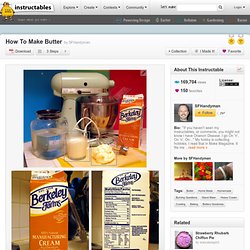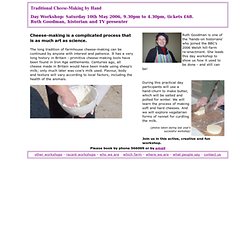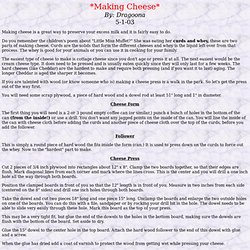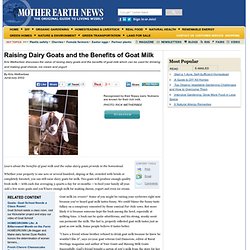

How to Make Butter. If you're using raw milk, separate cream from milk by letting the milk sit for 12 to 24 hours in the refrigerator until the cream comes to the top of the milk.

Use a large spoon or dipper to take the cream from the top of the milk. How To Make Butter. In 90 seconds, a stand mixer can break 1 cup (about .25 L) of cream down into the butter and buttermilk stage.

Like a lot of people, the first time I made butter, it was an accident. I was whipping some cream and got distracted. I got back just in time to see the whipped cream separate into butter and buttermilk. (Hmmmm... I don't think that ever happened with the powered whip cream mix Mom bought.- I love you Mom, but you know - you and cooking = Pellegrino and Crisco.) I was bummed that I screwed up the whip cream, but It was still really cool how it became butter in just seconds.
I always find that these kinds of things are a lot easier, and less intimidating, if you can watch someone do it. In the video I use 2 cups (a little less than .5 L) of cream so it takes twice as long. With washing, it only takes a little over 9 minutes to go from 100% Heavy Cream to finished homemade butter. These are the ingredients.Manufacturing Cream (or Heavy Cream)Sea Salt (optional) How to Use An Old, Primitive Butter Mold Press.
How to Make Buttermilk. Sheep 101: Dairy sheep. Got milk?

History Sheep have been raised for milk for thousands of years and were milked before cows. The world's commercial dairy sheep industry is concentrated in Europe and the countries on or near the Mediterranean Sea. The dairy sheep industry is in its infancy in the United States. There are approximately 100 dairy sheep farms in the U.S. They are found mostly in New England and the Upper Midwest. Highly nutritious Sheep milk is highly nutritious, richer in vitamins A, B, and E, calcium, phosphorus, potassium, and magnesium than cow's milk. According to a German researcher, sheep milk has more conjugated linoleic acid (CLA) than the milk from pigs, horses, goats, cattle, and humans.
Cheese Making for Beginners. How to Make Sheep Cheese. How to Make Goat Cheese. Goat cheese. Goat cheese Goat cheese, or chèvre (/ˈʃɛvrə/ or /ˈʃɛv/; from the French word for goat), is cheese made out of the milk of goats.

Properties[edit] Cow's milk and goat's milk have similar overall fat contents.[1] However, the higher proportion of medium-chain fatty acids such as caproic, caprylic and capric acid in goat's milk contributes to the characteristic tart flavor of goat's milk cheese. (These fatty acids take their name from the Latin for goat, capra.)[2] Goat milk is often consumed by young children, the elderly, those who are ill, or have a low tolerance to cow's milk. Goat cheese has been made for thousands of years, and was probably one of the earliest made dairy products. Goat cheese softens when exposed to heat, although it does not melt in the same way many cow cheeses do. Cheese-making by Hand. Cheese-making is a complicated process that is as much art as science.

The long tradition of farmhouse cheese-making can be continued by anyone with interest and patience. It has a very long history in Britain - primitive cheese-making tools have been found in Iron Age settlements. Making Cheese. *Making Cheese*By: Dragoona5-1-03 Making cheese is a great way to preserve your excess milk and it is fairly easy to do.

Do you remember the children's poem about "Little Miss Muffet? " She was eating her curds and whey, these are two parts of making cheese. Curds are the solids that form the different cheeses and whey is the liquid left over from that process. The whey is good for your animals or you can use it in cooking for your family. The easiest type of cheese to make is cottage cheese since you don't age or press it at all. How to Milk a Sheep. Want Milk? Get Goats - Sustainable Farming.
Goats: Why Raw Goat Milk?

Why raw milk? Why goat milk? Things to consider for good health and nutrition for you family. Also a... Learn about the benefits of goat milk and the value dairy goats provide to the homestead. Whether your property is one acre or several hundred, sloping or flat, crowded with brush or completely forested, you can still raise dairy goats for milk. Milking a Goat. Since "How to milk a goat" is not a topic that's likely to make you the hit of your next party, I assume you're reading this either because you're contemplating purchasing dairy goats, or you already have some new additions in your barn that are about to kid.

To that, I say, congratulations! I remember being in the same position many years ago. Since I had planned to bottle-raise the expected kids on a CAE prevention program of heat-treated colostrum and pasteurized milk, I had fears of not being able to obtain the colostrum or milk from the does, resulting in the kids starving to death. Add to my misgivings about learning how to milk a goat the irreconcilable advice to both feed a newborn kid within half an hour of birth, and heat-treat the colostrum first--which would take a little over an hour--and it was more stressful than giving birth to my own children!
As you probably guessed, though, it all worked out. And, before we begin--relax! So, let's get started! How to Milk Your Goat. 2 Ways to Milk a Cow. Edit Article By HandBy Machine Edited by Docburkhart, Maniac, Krystle, Sondra C and 46 others If you ever find yourself face-to-udder with a cow, you might find yourself having a hard time actually getting milk from your bovine companion.

It's not as easy as it looks, especially if there's a milking machine involved. And if the cow is cranky, it can be downright dangerous. Ad Steps Method 1 of 2: By Hand 1Make sure the cow is tied with a halter to a sturdy post or held in a stanchion. 11Move on to milk the other two teats. Method 2 of 2: By Machine 1Secure the cow in position as outlined above. 2Clean the teats as outlined above. 3Turn on the milking machine and allow it to build pressure. 4Hand-milk each teat a few times to let down the milk and check for mastitis (see Tips). 5Release the pressure so that suction begins. 6Place each suction device on each teat. 10Clean the machine. Video This video demonstrates the hand milk technique. Tips. How to Milk a Cow. Dairy farming. Rotary Dairy Shed A dairy is a business enterprise established for the harvesting of animal milk – mostly from cows or goats, but also from buffalo, sheep, horses or camels – for human consumption.

A dairy is typically located on a dedicated dairy farm or section of a multi-purpose farm that is concerned with the harvesting of milk. As an attributive, the word dairy refers to milk-based products, derivatives and processes, and the animals and workers involved in their production: for example dairy cattle, dairy goat. A dairy farm produces milk and a dairy factory processes it into a variety of dairy products. These establishments constitute the global dairy industry, a component of the food industry. History[edit] Milk producing animals have been domesticated for thousands of years. In the more recent past, people in agricultural societies owned dairy animals that they milked for domestic and local (village) consumption, a typical example of a cottage industry.
Industrial processing[edit]